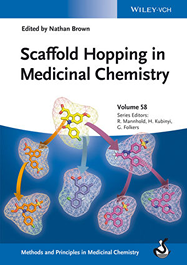Scaffold Hopping in Medicinal Chemistry
Material type: TextLanguage: English Series: Methods and Principles in Medicinal Chemstry : vol . 58Publication details: Weinheim : Wiley-VCH Verlag GmbH and Co., KGaA, c2014Description: XX, 304 p. : illISBN:
TextLanguage: English Series: Methods and Principles in Medicinal Chemstry : vol . 58Publication details: Weinheim : Wiley-VCH Verlag GmbH and Co., KGaA, c2014Description: XX, 304 p. : illISBN: - 9783527333646
- 615.19 BRO
| Item type | Current library | Shelving location | Call number | Copy number | Status | Date due | Barcode |
|---|---|---|---|---|---|---|---|
 Reference Collection
Reference Collection
|
Reference Section | Reference Section | 615.19 BRO | 2022-23 | Available | 98215 |
About the Author
Nathan Brown is the Head of the In Silico Medicinal Chemistry group in the Cancer Therapeutics Unit at The Institute of Cancer Research in London (UK). At the ICR, Dr. Brown and his group support the entire drug discovery portfolio together with developing new computational methodologies to enhance the drug design work.
Nathan Brown conducted his doctoral research in Sheffield with Professor Peter Willett focusing on evolutionary algorithms and graph theory. After a two-year Marie Curie Fellowship in Amsterdam in collaboration with Professor Johann Gasteiger in Erlangen, he joined the Novartis Institutes for BioMedical Research in Basel for a three-year Presidential Fellowship in Basel working with Professors Peter Willett and Karl-Heinz Altmann.
His work has led to the pioneering work on multiobjective de novo design in addition to a variety of discoveries and method development in scaffold hopping, bioisosteric identifi cation and replacement, molecular descriptors and statistical modeling. Nathan continues to pursue his research in all aspects of in silico medicinal chemistry.
SUMMARY:
This first systematic treatment of the concept and practice of scaffold hopping shows the tricks of the trade and provides invaluable guidance for the reader's own projects.
The first section serves as an introduction to the topic by describing the concept of scaffolds, their discovery, diversity and representation, and their importance for finding new chemical entities. The following part describes the most common tools and methods for scaffold hopping, whether topological, shape-based or structure-based. Methods such as CATS, Feature Trees, Feature Point Pharmacophores (FEPOPS), and SkelGen are discussed among many others. The final part contains three fully documented real-world examples of successful drug development projects by scaffold hopping that illustrate the benefits of the approach for medicinal chemistry.
While most of the case studies are taken from medicinal chemistry, chemical and structural biologists will also benefit greatly from the insights presented here.
